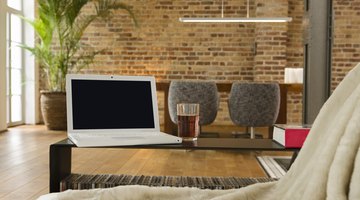How to Clean Interior Brick Walls
Table of Contents
As an accent or full wall around a fireplace or in the kitchen, bricks may seem impervious to anything, but if left unsealed, they absorb cooking oils, dirt, dust and debris -- not to mention soot when they're near a fireplace.

If you don't want to make your own formula to clean brick walls, use a commercial product suited to the bricks' age. Test your chosen cleaning solution on a small unnoticeable area first -- the older the bricks are, the more soft they become as well as susceptible to damage from vigorous cleaning.
Vacuum First
Before you start to remove dirt or smoke that's penetrated into the bricks, as when you have a brick wall that surrounds a fireplace, vacuum it first. Attach the soft brush to the wand on your vacuum to make it easy to go over the surface of the bricks. Start at the top left corner and work across and down the wall. Don't use a duster, because that just spreads the dirt everywhere.
Kitchen Brick Cleaning
Create a mixture of pumice -- the product meant for cleaning, not gardens -- liquid detergent, ammonia and hot water in a gallon bucket. Mix together about 1 cup of ammonia, 1/2 cup of detergent and enough pumice -- 1/2 to 1 pound -- with water to make a substance thick enough that you can paint it onto the brick. Let the mixture thoroughly dry, and then scrub with a hard-bristled brush dipped in hot water. Let the brick dry after you rinse it clean. Wear rubber gloves as you work to protect your hands. This mixture cuts through kitchen soot and grease left on brick walls.
Bricks Near the Fireplace
Add 3 quarts of water to a pan on the stove. Peel or shave an entire bar of naphtha soap into the pan using a potato peeler or utility knife. Let the mixture boil until all the soap melts. After it's cool to the touch, add 1 pound of pumice and 1 cup of ammonia to the solution and mix thoroughly. Apply the solution to the brick wall working from left to right and from the top down. Let the solution work into the brick for at least an hour before you scrub it with a stiff-bristled brush. Rinse any remaining material away with warm water. Apply additional detergent mixed with water for the second washing, if needed.
Older Bricks
For older bricks -- at least 50 years or so -- you don't want to apply the solution with pumice to the wall because it may cause the brick to crumble in spots. For these walls, simply mix a mild liquid detergent, about 1/2 cup, into a gallon of warm water for cleaning. Apply to the wall with a soft-bristled brush; then rinse clean with warm water and let dry. Apply a seal coat to protect the bricks after cleaning.
Brick Sealing
Because bricks are so porous, they become catch basins for little bits of dust, debris, soot, pollen and any cooking oils in the room or house. One of the ways to keep bricks from getting so dirty starts with coating the bricks with a protectant oil after you clean and let them dry. A tung oil penetrating sealer fills in the little nooks and crannies in bricks with a protectant, which keeps the bricks from absorbing dirt, soot and grease.
The Drip Cap
- As an accent or full wall around a fireplace or in the kitchen, bricks may seem impervious to anything, but if left unsealed, they absorb cooking oils, dirt, dust and debris -- not to mention soot when they're near a fireplace.
- Mix together about 1 cup of ammonia, 1/2 cup of detergent and enough pumice -- 1/2 to 1 pound -- with water to make a substance thick enough that you can paint it onto the brick.
- Let the mixture thoroughly dry, and then scrub with a hard-bristled brush dipped in hot water.
- Apply additional detergent mixed with water for the second washing, if needed.
- For older bricks -- at least 50 years or so -- you don't want to apply the solution with pumice to the wall because it may cause the brick to crumble in spots.
- One of the ways to keep bricks from getting so dirty starts with coating the bricks with a protectant oil after you clean and let them dry.
Resources
Writer Bio
As a native Californian, artist, journalist and published author, Laurie Brenner began writing professionally in 1975. She has written for newspapers, magazines, online publications and sites. Brenner graduated from San Diego's Coleman College.
Photo Credits
- moodboard/moodboard/Getty Images
- moodboard/moodboard/Getty Images
More Articles


